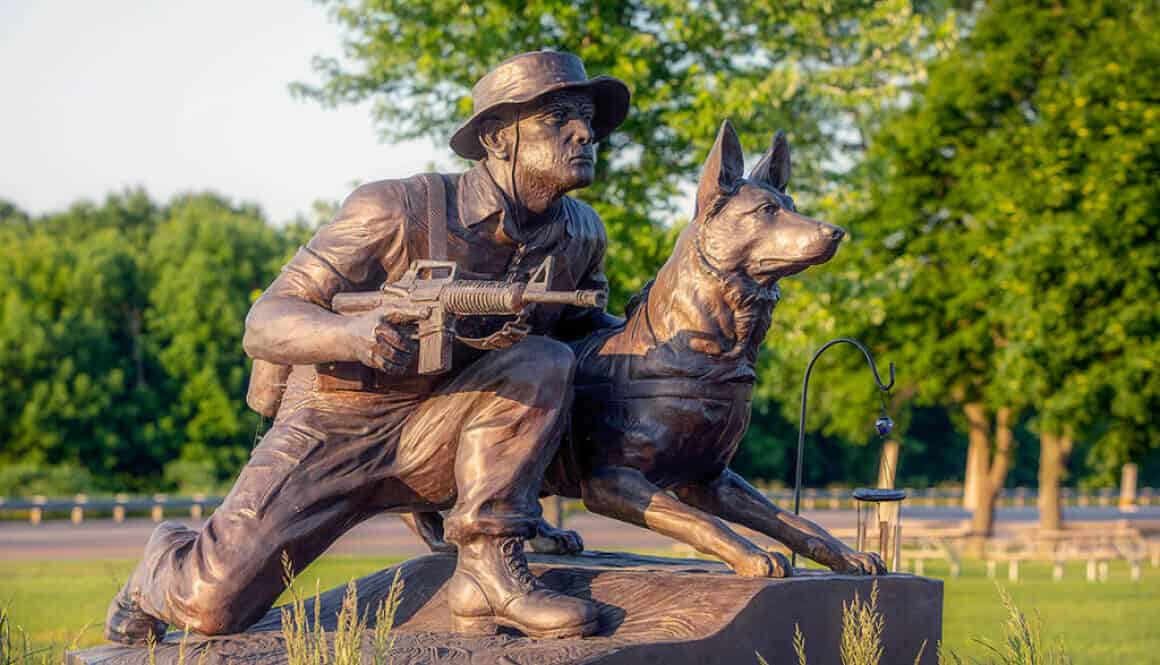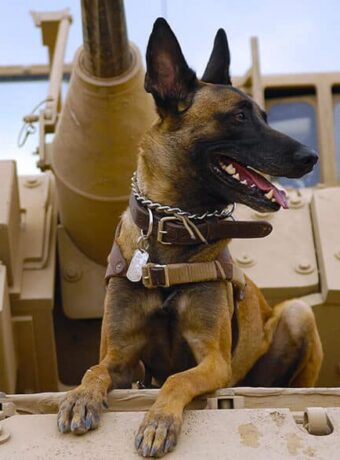Dogs in the Military

Ancient Times
Many breeds of dogs have been used as herders, hunters, and guard dogs throughout the years, so its not a surprise that dogs were used by the military and in wars. Dogs used in the military date back to 600 BC. Dogs have been used into wars by the Romans, Greeks, Persians, Egyptians, and Britons.
The earliest report on the use of dogs, involved the Alyattes of Lydia against the Cimmerians in 600 BC when it was written the dogs had killed invaders. Around the middle of the 7th Century BC, Magnesian horsemen were accompanied by war dogs and attendants carrying spears when they went to war against the Ephesians. They released the dogs at the appropriate time to breach the enemy ranks, followed by a spear assault and then a cavalry charge.
The Greeks and Romans armies were known to have gone in to wars with their ferocious war dogs. The Molossian or Neapolitan Mastiff, both native to Greeks and Romans were used by both armies. These dogs were vicious hounds. The Roman’s equipped their dogs with very large spiked collars.
In 55 BC, during Caesar’s invasion of Britain, they found themselves being opposed by Celtics warriors accompanied by ferocious English Mastiffs. King Frederick II or Frederick the Great and Napoleon also used dogs as guard dogs and messengers during their wars. In the 1500’s Spanish Conquistadors again used Mastiffs when they fought against the native Americans.
The first known use in the United States was during the Seminole Wars. During the Civil War, dogs were used as both messengers and guard dogs. In the Afghan War in 1880, a Mascot of the 2nd Battalion named Bobbie was the only survivor during the battle of Maiwand. Later the dog (Bobbie) was awarded the Afghan medal in 1881 from Queen Victoria.
Once modern weapons and guns arrived, the dog’s role began to change. Their roles began to be less on the aggressor side and more for guarding, patrolling, explosive detecting, tracking as well as mascots and companions.
World War I (1914-1918)
In the First World War, dogs were used for many different roles. This included roles such as guard dogs, messenger dogs, rescue dogs, pack dogs, sentry dogs and dogs trained to detect the enemy.
During the first World War, Germany was known to have the largest army of war dogs in the world. They were mostly Alsatians. They were said to have somewhere near 28,000 dogs including nearly 4,000 Red Cross dogs and 4000 that were used for patrols and as messengers. The Germans also had dog trained to detect gas, to alert troops that gas masks needed to be worn.
At the start of WW I, France had approximately 250 dogs in use. Belgian armies were also known to use dogs to pull their Maxim Guns that sat on wheeled carriages and they also used dogs for transporting their supplies or pack dogs. In New Zealand army and navy both have dogs as mascots. The United States also used dogs. Some were even able to detect incoming artillery shells before the troops could hear them. One such dog that has been written about was named Stubby. Troops used to watch the dog and wait for him to alert them on when to take cover. This dog was even promoted to Sergeant and was considered a hero. Later after returning to the United States, he became the mascot for the Washington Hogas football team.
World War II (1939-1945)
During the second world war dogs again played a big part and had many different roles. The Soviet army used dogs to help the wounded, moving them on sleds in snow. In one battle, over 1200 wounded men and over 300 tons of ammunition were moved by dogs pulling sleds. Dogs were used many a time to detect mines. In German concentration and prisoner of war camps, dogs were used heavily as guard dogs. If a prisoner escaped, the dogs were then used to track them down. During the invasion of Russia by Germany, Russian dogs were trained for quite a different role. They Russians equipped their dogs with mines with magnets that would explode when the dogs went under German Panzer tanks.
The United States used German Shepherds and Doberman Pinschers to track down their enemies in battles. During WW II a German Shepherd, Siberian Husky mix named Chips became quite the famous dog for the United States. Chips at one point broke away from his handler while in Sicily, encountering the enemy and attacking the gunner inside his holdout. This led to the gunners surrender and capture. More stories can be traced back to Chips and later he was awarded the Distinguished Service Cross, Silver Star and Purple Heart if can believe it. Sadly all his medals were later revoked because policy prevented animals from receiving commendations. On a happy note, Chips made it through the war and was returned to his original family after the war ended.
Vietnam War (1955-1975)
During the Vietnam War, the United States was said to have over 5,000 dogs and close to 10,000 soldiers/handlers. Most dogs were said to have been used as sentry dogs and guarding bunkers, airbase perimeters and gun towers. Dog were also used heavily to detect mines and traps.
Vietnam Military Working Dog Memorial
Below is an amazing video of the Vietnam Military Working Dog Tribute located at the Wisconsin Highground Veterans Memorial Park, located Neillsville Wisconsin. The amazing bronze sculpture depicts a Vietnam Era military dog and his handler. The sculpture was designed and created by Michael Martino of LaCrosse Wisconsin in 2018. The Highground as some call this memorial park is located 4 miles west of Neillsville on Ridge Road and was built as a tribute to the surviving and fallen military personnel.
Modern Day Military Dog
Nowadays dogs still participate heavily in military operations. The German Shepherd and the Belgian Malinois are still the most preferred breeds used by the military. Belgian Malinois being lighter and shorter, make them more suited for rappelling and parachuting operations.
Today’s military dogs wear tactical vests, goggles, cameras, earpiece, microphones and more. Many times, a dog with a camera on the back and an ear piece will enter a danger zone before humans. The camera on the back allows the humans to see what the dog sees and the earpiece allows the handler to relay commands to the dog at very low volumes. They jump out planes with their handlers and help bring down some of the most notorious and wanted people around the world. Seal team dogs today are trained parachutists. If they are jumping in water, they always jump solo.
Service Dogs used by the United States Army, once retired are now allowed to return home and are put up for adoption. Speaking or retired dogs, a Seal (Belgian Malinois) named Cairo was one such dog that received quite a bit of media coverage. He had been trained to Skydive, bite and release on command, sniff out explosives, and move quickly and quietly through all types of terrains. He became famous when he was part of the Seal Team that in 2011 attacked Osama Bin Laden’s compound in Pakistan. Later he went on to live with his handler back in the United States.
Throughout the years dogs have served mankind through so many battles and confrontations and have contributed so much in historical battles. Even after World War II and the Vietnam War, many of our canine friends never made it back home after war, many were just euthanized. Thankfully, since then, new legislations were passed where our canine friends’ welfare now has meaning protection.
In recent years, the sacrifices and heroism of military working dogs have gained more attention, and memorials have even been erected in their memory.
